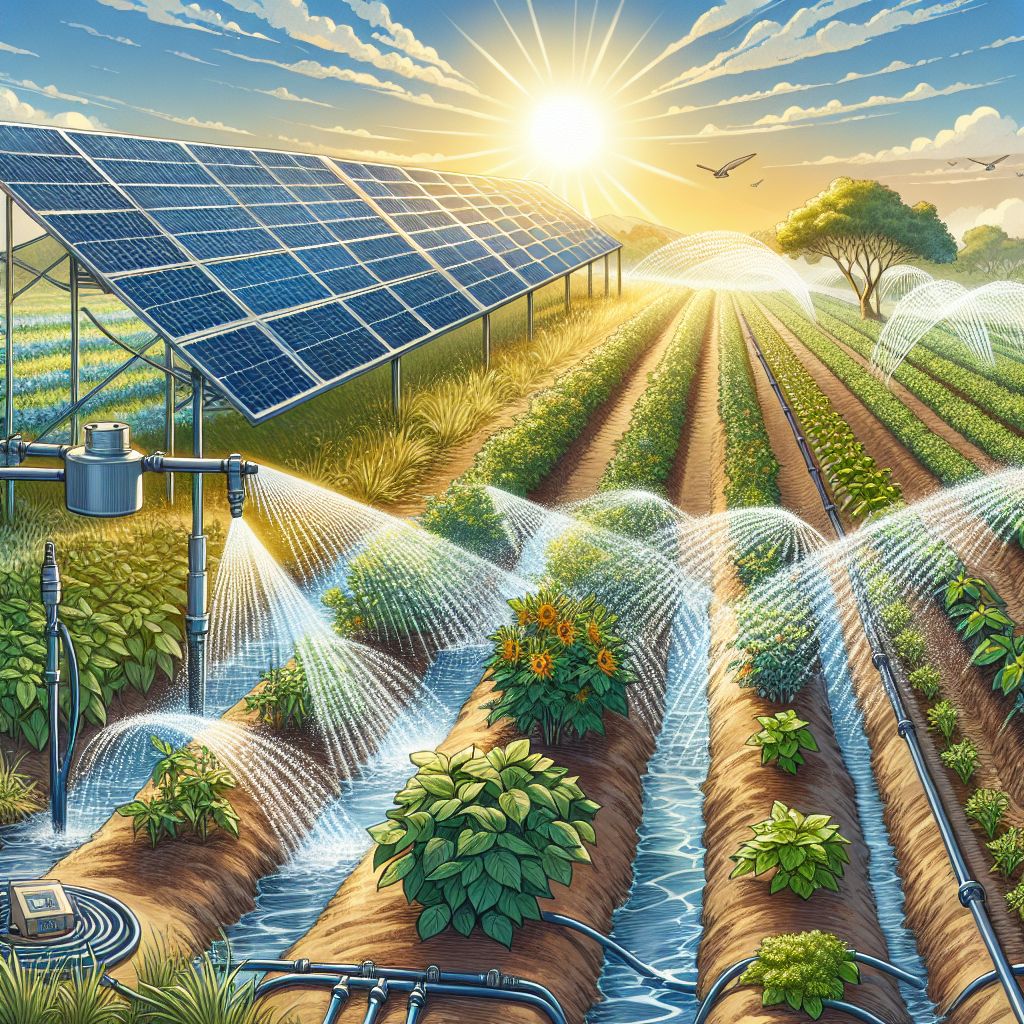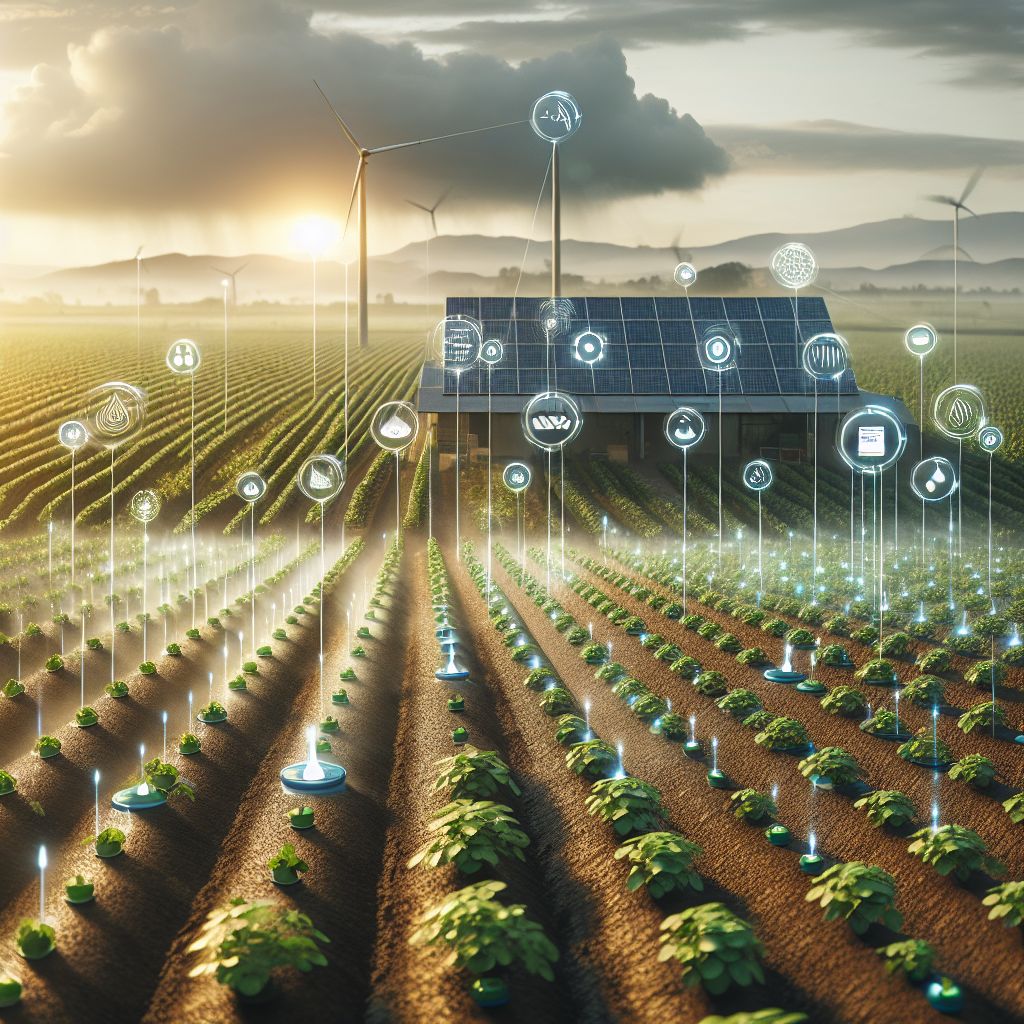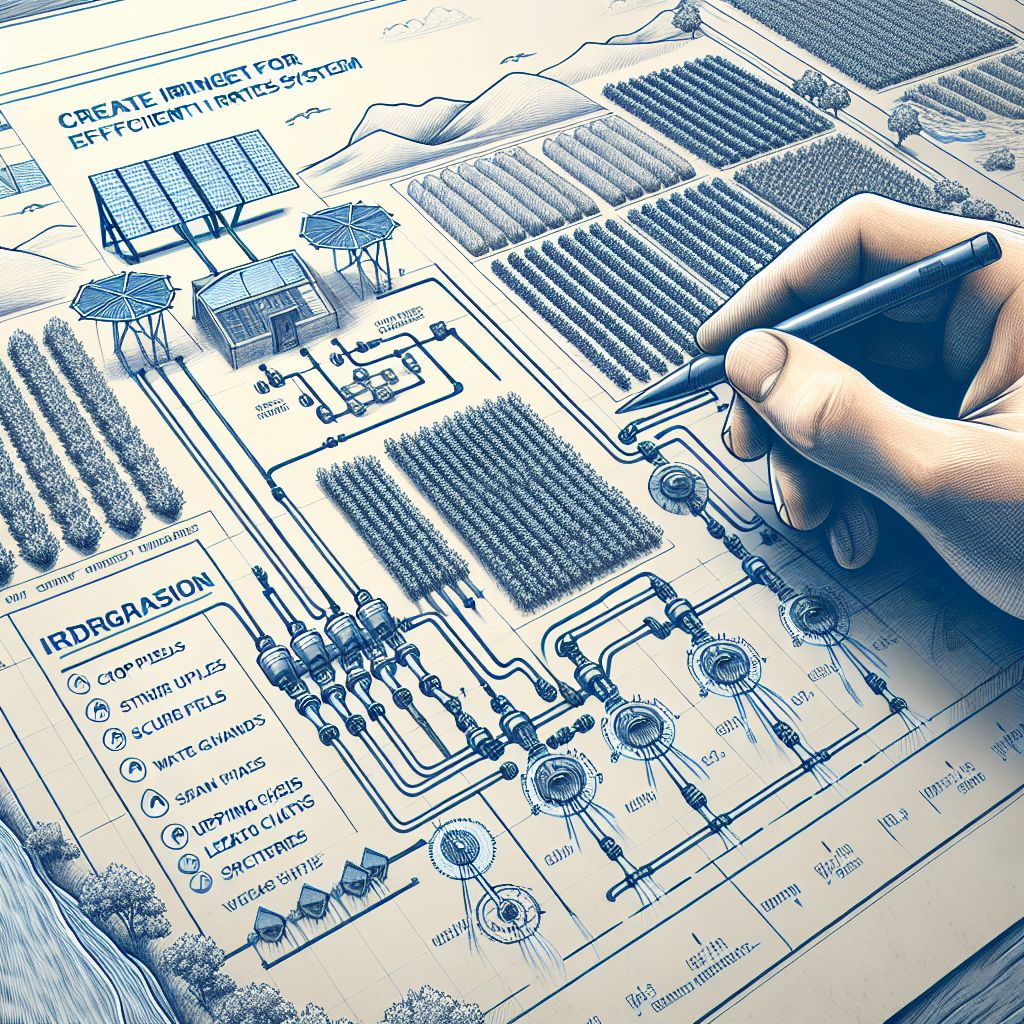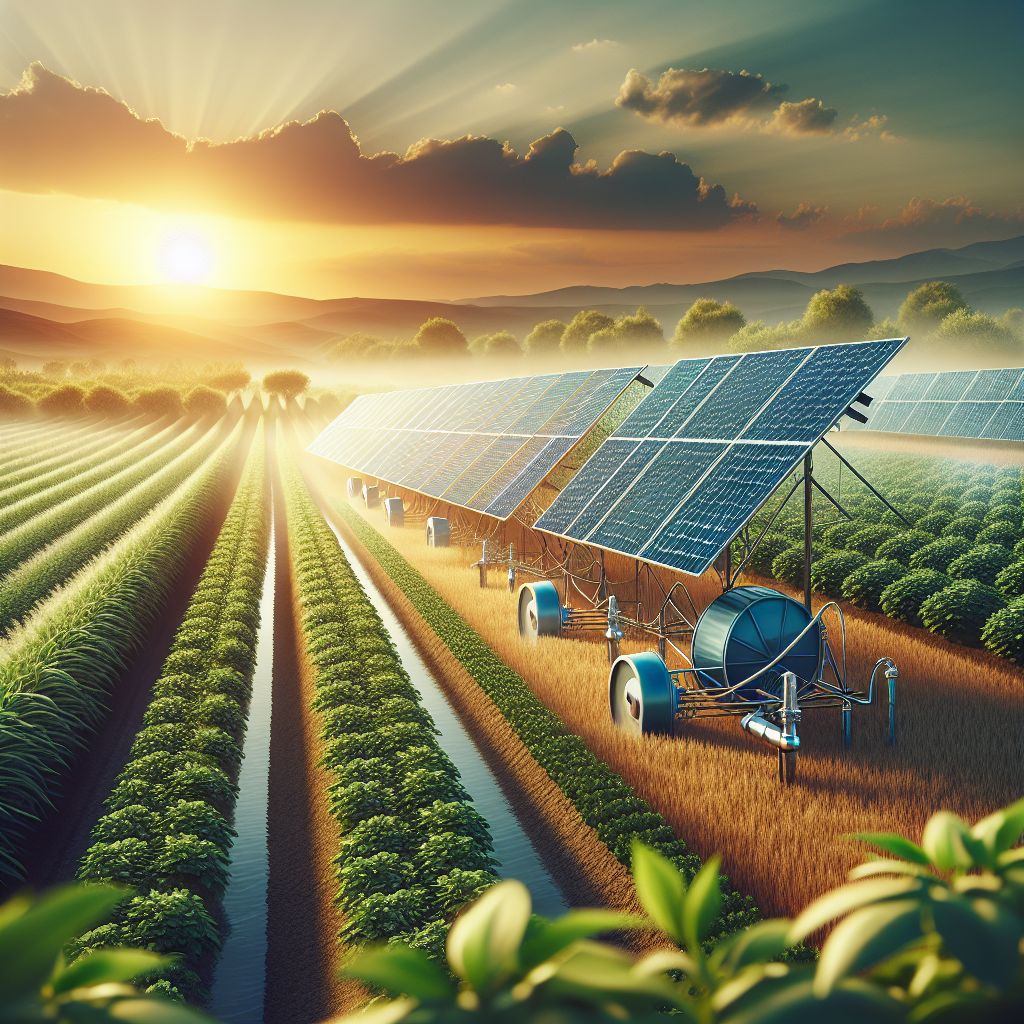
Key Takeaways
Farms can greatly reduce their energy costs and increase their sustainability by using solar-powered irrigation systems.
Drip irrigation is a highly efficient method of delivering water and nutrients directly to plant roots, making it suitable for a wide range of crops.
For smaller farming operations, soaker hoses are a simple and cost-effective solution.
Sprinkler systems offer flexible watering options and can be used on farms of all sizes and for all types of crops.
Monocrystalline solar panels are more expensive, but they provide higher efficiency rates and longer lifespans, making them ideal for solar irrigation systems.
The Importance of Efficient Irrigation for Modern Farms
Water is the lifeblood of any farm, but it’s also a resource that needs to be used responsibly. Efficient irrigation is not just about conserving water; it’s about making sure every drop counts for the health of your crops and your profit margin. After all, wasting water is the same as wasting money.
Saving Water
Why bother saving water? For one thing, it’s environmentally friendly. But it’s also a way to make your farm more sustainable and resilient. By using water more efficiently, you’re making your farm more drought-resistant and better able to cope with water shortages. And that’s increasingly important in our changing climate.
Water conservation also means energy conservation. Moving water requires power, and the more water you need to move, the more power you need. That’s where solar panels come in. They convert the sun’s energy into a cost-effective power source for your irrigation needs.
Increasing Harvest Production
Efficiency equals productivity. By delivering water and nutrients directly to the roots of your plants, you’re likely to see a boost in your harvest. Healthy crops that receive the right amount of water will grow faster and stronger, leading to a larger yield during harvest season.

Most Efficient Irrigation Methods
It is crucial to select the most efficient irrigation method. There are several techniques available, but let’s concentrate on those that work best with solar power to get the most out of your investment.
Drip Irrigation: A Thirst-Quenching Solution for Your Crops
Imagine giving each of your plants its own water supply. That’s what drip irrigation does. It delivers water right to the roots of your plants, reducing evaporation and runoff. It’s a smart move for any farmer, and it becomes even more intelligent when you use solar power to run it.
Understanding Drip Irrigation
Think of a series of pipes crisscrossing your farm, each one providing a constant, exact amount of water to your plants. That’s what drip irrigation is all about. It’s a system made up of valves, pipes, and emitters that are designed to deliver water directly to the base of each plant.
The Advantages of Drip Irrigation
With drip irrigation, you’re not just conserving water; you’re also saving time and effort. Here’s why it’s a revolution:
Efficiency: Water is delivered directly to the roots of the plants, which reduces waste.
Control: It’s simple to adjust the amount of water each plant gets.
Health: Fewer diseases and healthier plants due to less water on the leaves.
Most Suitable Crops for Drip Irrigation
While most crops will do well with drip irrigation, it’s particularly beneficial for row crops such as tomatoes, peppers, and strawberries. If you’re growing anything in rows, drip irrigation is likely to make your job easier and your crops healthier.
Soaker Hoses: A Simple and Effective Way to Water Your Plants
If you are a beginner or if you have a smaller garden, soaker hoses could be a good option for you. They are easy to install, use and can be very effective when used with solar power.
Installing Soaker Hoses
Installing soaker hoses is as easy as arranging them along your plants and connecting them to a water source. When you turn on the water, it seeps out through tiny pores in the hose, providing a gentle, even watering to your plants’ roots.
Benefits Compared to Conventional Techniques
Soaker hoses have some impressive benefits compared to conventional watering techniques:
They require less work than watering by hand.
They are more water-efficient than overhead sprinklers.
They help prevent the spread of disease by keeping water off the leaves of plants.
Sprinkler Systems: Flexible Watering Solutions
If you need to water a large area quickly, sprinkler systems are the way to go. They’re adaptable to a variety of farm layouts and types of crops.
Choosing the Right Sprinkler System
There are many types of sprinkler systems, from stationary to traveling, and each has its own strengths and weaknesses. The best one for your farm will depend on the crops you’re growing and the type of soil you have.
Why Choose Sprinklers Instead of Drip Systems?
Sprinklers are the way to go when you need to water a large area or when your crops aren’t very sensitive to leaf moisture. They’re also excellent for managing pastures and can even be used to protect crops from frost.
Old-School Furrow Irrigation: A Reliable Way to Water Your Crops
Before we get into the more advanced options, let’s remember the reliable techniques like furrow irrigation. This approach includes making furrows along the crop rows and letting water flow down these little furrows. It’s straightforward and doesn’t need sophisticated equipment, which can be a benefit for many farmers.
When Should You Use the Traditional Methods Over Other Systems
There are moments when the conventional way is the best way. For example, if you’re dealing with crops that are planted in rows and can handle moist soil conditions, furrow irrigation could be just the ticket. It’s also a good choice if you’re looking for a low-cost method to start with, particularly if you’re farming on flat land.
For instance, a potato farmer with a flat field might choose furrow irrigation because it’s affordable to implement and the crop can tolerate the moisture levels. The farmer considers this method water-efficient and easy to handle without the need for advanced equipment.
However, it’s important to mention that furrow irrigation can be less efficient than other methods if not managed correctly, as water can evaporate or run off before it’s absorbed by the soil.
Why Farmers Should Use Furrow Irrigation
Furrow irrigation is not only a tradition, but it also has some significant benefits:
It’s affordable to install and run.
It can be easily modified to accommodate different types of soil and conditions.
It’s suitable for certain crops and field conditions.
For instance, a farm with heavy clay soil might do well with furrow irrigation because the water moves slowly, giving the soil more time to soak it up and reducing waste.
Here is a table showing the pros and cons of different irrigation systems a farmer can use on a farm:
|
Irrigation System |
Pros |
Cons |
|---|---|---|
|
Drip Irrigation |
– High water efficiency (90%+). 1 |
– High initial cost. 4 |
|
Soaker Hoses |
– Simple to install and use. 6 |
– Less efficient than drip irrigation. 6, 7 |
|
Sprinkler Irrigation |
– Relatively inexpensive to install. 5 |
– Lower efficiency than drip (60-80%). 1 |
|
Furrow/Surface Irrigation |
– Very low efficiency (50-60%). 1 |

Smart Irrigation: How Technology Can Help Manage Water
Now let’s talk about technology. Smart irrigation removes the guesswork from watering with devices and tools that can make decisions for you. It’s like having a farm worker who’s always on the job, making sure your crops get just the right amount of water at just the right time.
Automatic Timers and Controllers
Imagine never having to worry about turning the irrigation system on or off again. That’s what automatic timers and controllers can do for you. They can be programmed to water your crops at the optimal times, which means you can sleep in or take that weekend off without stress.
Boosting Efficiency with Automation
Set timers to water during the coolest part of the day to reduce evaporation.
Use controllers that adjust watering based on rainfall, so you’re not wasting water.
Program your system to apply water at a rate that your soil can absorb, avoiding runoff.
With automation, you’re not just saving time; you’re also using water and energy more efficiently. And when you pair these systems with solar panels, you’re using the sun’s power to keep your crops hydrated without a high energy bill.
Using Sensors and Monitoring to Make Informed Decisions
Sensors are the tools that provide your smart irrigation system with the ability to see and hear what’s happening on your farm. They can provide you with information you might not be able to gather on your own, such as the moisture level in your soil or the temperature at the root level. With this information, you can make decisions about when to water and how much water to use.
Types of Sensors Used in Smart Irrigation
Nowadays, there’s a sensor for nearly everything:
Soil moisture sensors gauge the amount of water accessible to your crops.
Rain sensors can turn off your system during rainfall, preventing water waste.
Temperature sensors can guard your crops against frost damage by modifying watering schedules.
These sensors can be connected to your solar-powered system, merging technology and nature seamlessly. It’s not only intelligent farming; it’s intelligent business.

Planning Your Efficient Irrigation System
Having a solid irrigation plan is like having a blueprint for water efficiency. It allows you to determine the most effective method for providing your crops with water without any waste. Plus, if you’re using solar panels, you want to ensure that you’re making the most of that investment.
Understanding Your Soil and Crops
Each type of crop and soil has different requirements. Begin by familiarizing yourself with the specific conditions of your farm. Examine your soil to determine its texture and ability to retain water. Learn about the water needs of your crops at each stage of their development. This information will enable you to use water in the most effective manner.
Creating a Personalized Irrigation Scheme
With this information in hand, you can create an irrigation scheme that fits your farm like a glove. Consider where your crops are located, the gradient of your land, and the best position for your solar panels to catch the sun. It’s like fitting together a jigsaw puzzle where the pieces are the resources available on your farm.
What to Think About for Various Farm Sizes and Types
Every farm is unique, which means there’s no such thing as a universal irrigation plan. Here are some factors to take into account: irrigation system components can vary greatly depending on the specific needs of your crop and farm size.
Ensure that the design is proportional to the size of your farm—avoid overbuilding or underbuilding.
Consider the types of crops you’re cultivating and their unique requirements.
Bear in mind that the positioning of solar panels can affect their efficiency, so choose carefully.
Creating an effective irrigation plan requires time and consideration, but the positive impact on your crops and your farm’s profitability makes it worthwhile.
How to Maintain Efficiency Over Time
As with any other piece of farm equipment, your solar-powered irrigation system requires regular maintenance to continue functioning properly. Here are some suggestions to help you keep everything in order:
Ensure your solar panels are clean to maintain their maximum efficiency.
Regularly check your irrigation system for any leaks or clogs that could waste water.
As your crops grow and as the seasons change, update your irrigation schedule.
Although maintenance might not be the most thrilling aspect of farming, it’s crucial for maintaining your system’s efficiency and effectiveness.
Let’s make the efficient irrigation system even more efficient by adding solar panels to it. We will now take a look into the solar panel field.

Top Solar Panels You Can Add to the Irrigation System to Make it More Efficient
In the realm of agriculture, efficient irrigation holds paramount importance for maximizing crop yield and minimizing water usage. Embracing solar energy in your irrigation system can significantly enhance its efficiency and reduce the associated energy costs.
Investing in solar panels for your irrigation system is a smart decision that benefits both your wallet and the environment. By harnessing the power of the sun, you can ensure your farm thrives while reducing your carbon footprint. Choose the right solar panel option based on your needs and enjoy the benefits of efficient, sustainable irrigation.
Monocrystalline Panels: Efficiency Meets Farming
Monocrystalline solar panels are the pinnacle of efficiency and reliability for irrigation systems. Their superior energy conversion efficiency, long lifespan, and durability make them an ideal investment for farmers seeking to optimize their irrigation operations. By integrating monocrystalline panels into your system, you can significantly reduce energy costs, enhance irrigation efficiency, and contribute to a more sustainable and profitable farming operation. As the demand for sustainable agriculture grows, monocrystalline solar panels will continue to play a crucial role in transforming the future of irrigation.
Benefits for Using This Efficient Panel
Monocrystalline solar panels are the crème de la crème of solar technology, renowned for their exceptional efficiency and durability.
High Efficiency: Monocrystalline panels boast the highest efficiency ratings among solar panels, typically ranging from 15% to 22%.
Long Lifespan: Monocrystalline panels are known for their exceptional longevity, with a lifespan of over 25 years.
Durability and Reliability: Monocrystalline panels are robust and can withstand harsh weather conditions, such as hail and wind. Their sturdy construction ensures consistent performance and minimal maintenance throughout their lifespan.
Space Optimization:** The high efficiency of monocrystalline panels allows for more compact arrays, minimizing the space required for installation.
Monocrystalline solar panels are the pinnacle of efficiency and reliability for irrigation systems. Their superior energy conversion efficiency, long lifespan, and durability make them an ideal investment for farmers seeking to optimize their irrigation operations.
Downsides of Using Monocrystalline Panels on a Farm
Even though monocrystalline solar panels are highly efficient, their high cost can be a roadblock for some farmers. They also take up a lot of space and might not be the most practical option for smaller farms with limited land.
Despite their efficiency, monocrystalline panels have a few disadvantages. They’re more expensive upfront, which can be a problem if you’re on a tight budget. They’re also quite rigid, so they’re not the best choice if your farm has an irregular shape or if you need a more flexible setup.
On top of that, they work best in direct sunlight, so if your farm is in a region with a lot of overcast days, you might not see the full advantages of these panels. It’s important to think about your local weather and whether the investment will be worthwhile in the long term.
Finally, if a monocrystalline panel is shaded or damaged, the efficiency of the entire system can decrease dramatically. This means that you need to pay extra attention to where you place it and how you maintain it to make sure you’re getting the most from your investment.
Polycrystalline Panels: A Budget-Friendly Solution for Irrigation
Polycrystalline solar panels have become a go-to for many farmers because of their affordability and decent performance. They are created by melting several silicon crystals together, which is a simpler and less expensive process compared to the production of monocrystalline panels.
Polycrystalline panels may not be as efficient as monocrystalline panels, but they are still a dependable power source for irrigation systems. If you’re trying to find a balance between cost and performance, they’re a good option.
Why This Panel is Good for You
Polycrystalline panels aren’t just a way to save some money. They provide a fantastic mix of efficiency and worth. Here’s why they might be the best option for your farm:
They are less expensive, allowing you to begin using solar irrigation without a significant initial investment.
They have an uncomplicated production process, which is more environmentally friendly.
They function well in a range of climates, making them a flexible choice for many farms.
Polycrystalline panels are a reliable workhorse that will power your irrigation system consistently, without draining your wallet.
One more benefit is that polycrystalline panels aren’t as impacted by high temperatures as monocrystalline panels. This can be especially useful if your farm is situated in a warm climate.
Since they are not as sensitive to shading, you don’t have to fret as much about the location of each panel. This gives you more freedom when planning your solar array.
Disadvantages of Using Polycrystalline Panels in Agriculture
Due to their lower efficiency, you may need to install more panels to meet your power requirements, which will take up more space.
Their fragmented appearance and blue color may not be as visually appealing as the sleek black of monocrystalline panels.
Despite their good heat tolerance, their performance may decrease on particularly hot days, which could disrupt your irrigation schedule.
When deciding between the two, consider the size of your farm and how much space you can allocate for solar panels. If you’re short on space, the lower efficiency of polycrystalline panels may be a dealbreaker.
Additionally, consider how they would appear on your farm. If you care about aesthetics, you might not choose the blue, speckled design of polycrystalline panels.
Just keep in mind that on those really hot summer days, you might not generate as much power as you need, which could mean your irrigation system won’t run as long as you want it to.
Thin-Film Solar Panels: A New, More Versatile Option
Thin-film solar panels are the latest innovation in solar technology, and they’re changing the game with their versatility and simple installation process. These panels can be unrolled and laid out like a carpet, making them ideal for covering large or irregularly shaped areas, such as those used in solar-powered irrigation for agriculture.
Reasons to Use this Flexible Panel on Your Farm
Thin-film panels are revolutionizing farms with unconventional layouts or those that need to cover large areas fast. Here are some reasons why you might want to think about using them:
Being lightweight and flexible, they can be mounted on a variety of surfaces, including those that can’t support the weight of heavier panels.
Their installation is simple, potentially saving you time and labor expenses.
They work well in low-light conditions, making them a good option for areas with frequent cloud cover or indirect sunlight.
If your farm has a lot of unused space like rooftops or if you’re in need of a quick and easy solar solution, these panels can be a wise choice.
Why a Farmer Might Avoid Thin-Film Solar Panels
While thin-film panels have their benefits, they also have several drawbacks. They are the least efficient type of solar panel, so you would need many more of them to produce the same amount of power as monocrystalline or polycrystalline panels. They also don’t last as long, which could lead to more frequent replacements and greater costs over time.
Here is a table showing the pros and cons of using different types of solar panels with an irrigation system on a farm:
|
Panel Type |
Pros |
Cons |
|---|---|---|
|
Monocrystalline Panels |
– High efficiency (15-22%), producing more power per square foot. 1, 2, 4 | |
|
Polycrystalline Panels |
– Lower upfront cost than monocrystalline. 1, 2 |
– Lower efficiency and shorter lifespan than monocrystalline. 2, 4 |
|
Thin-Film Solar Panels |
– Lowest upfront cost. 1, 2 |
– Lowest efficiency (7-13%). 2, 4 |

Conclusion:
Wrapping up, linking your irrigation system to solar panels can result in increased efficiency and sustainability on your farm. Whether you opt for monocrystalline, polycrystalline, or thin-film panels, you’ll be lessening your carbon footprint and saving on energy expenses.
Remember, the best choice for your farm depends on a variety of factors, including budget, space, climate, and aesthetic preferences. Consider all these aspects carefully before making your decision. With the right setup, solar-powered irrigation can be a powerful tool in your farm’s sustainability arsenal.
Frequently Asked Questions:
Which irrigation system is the most efficient in terms of water usage?
Drip irrigation is often regarded as the most water-efficient irrigation system. It applies water straight to the roots of the plant, reducing evaporation and runoff. It is also energy-efficient when used with solar power, making it a preferred option for sustainable agriculture.
Is it possible to use efficient solar irrigation systems in any climate?
Indeed, efficient solar irrigation systems can be utilized in a variety of climates. Their effectiveness, however, will be determined by the amount of sunlight available. Solar-powered systems will naturally be more effective in areas with more sunny days, but even in less sunny climates, solar can still be a viable option, especially with thin-film panels that perform well in low-light conditions.
How do intelligent irrigation systems save water?
Intelligent irrigation systems save water by using sensors and automation to ensure that water is only used when and where it’s needed. They can adapt to the weather, soil moisture levels, and the specific needs of different crops, reducing waste and ensuring that every drop of water is used efficiently.
What is the initial investment to set up an efficient solar irrigation system?
The initial investment to set up an efficient solar irrigation system can vary greatly depending on the size of your farm, the type of solar panels you choose, and the complexity of your irrigation needs. Generally, you can expect to pay anywhere from a few thousand to tens of thousands of dollars for a complete system. However, many farmers find that the long-term savings on energy costs make solar irrigation a worthwhile investment.
How frequently should you maintain a solar irrigation system to ensure it’s working at its best?
You should regularly inspect a solar irrigation system for any potential problems, such as clean panels, intact wiring, and working pumps and sensors. You should conduct a detailed inspection at least once a year, but it’s better to check more often, particularly after severe weather or during the busiest growing seasons.







Leave a Reply